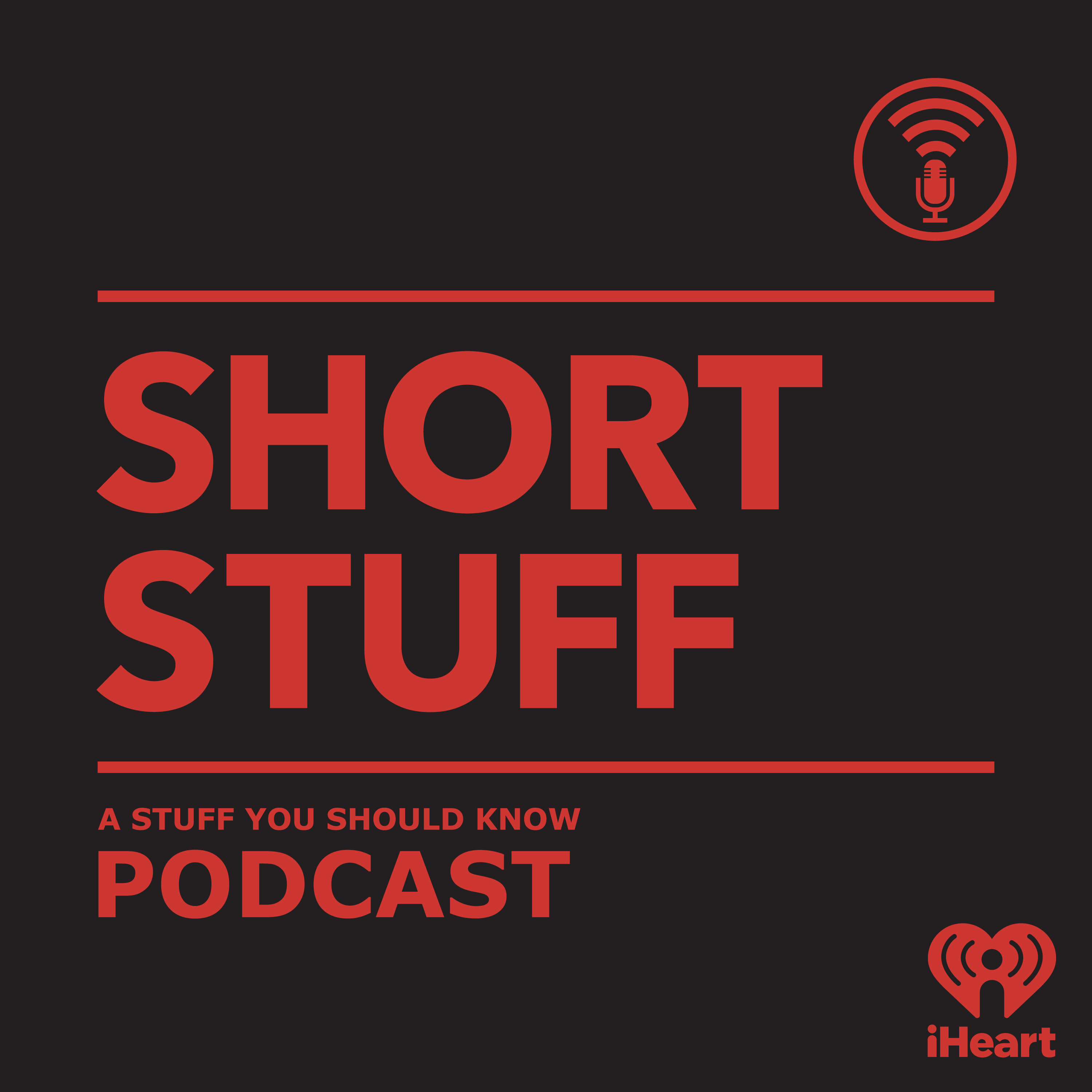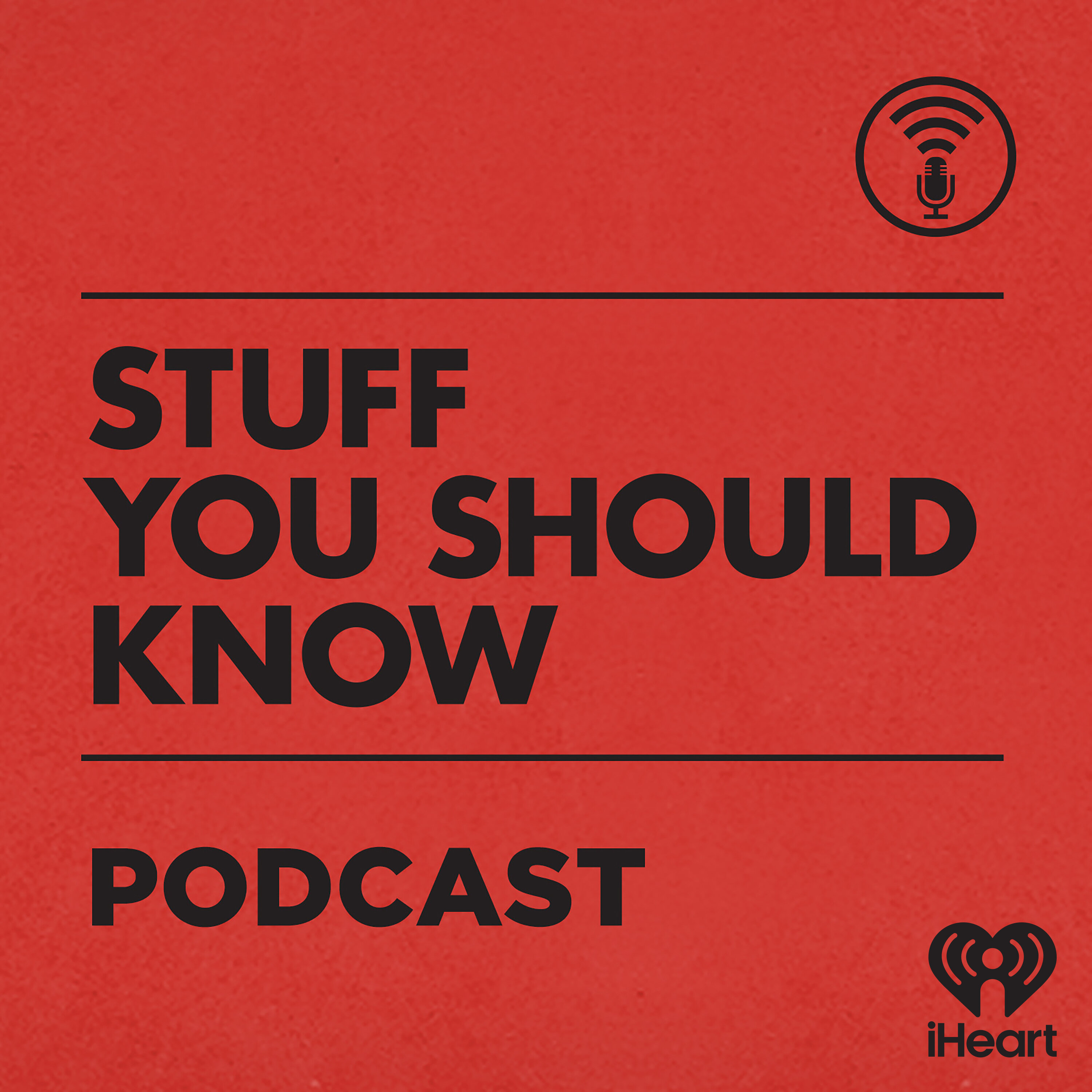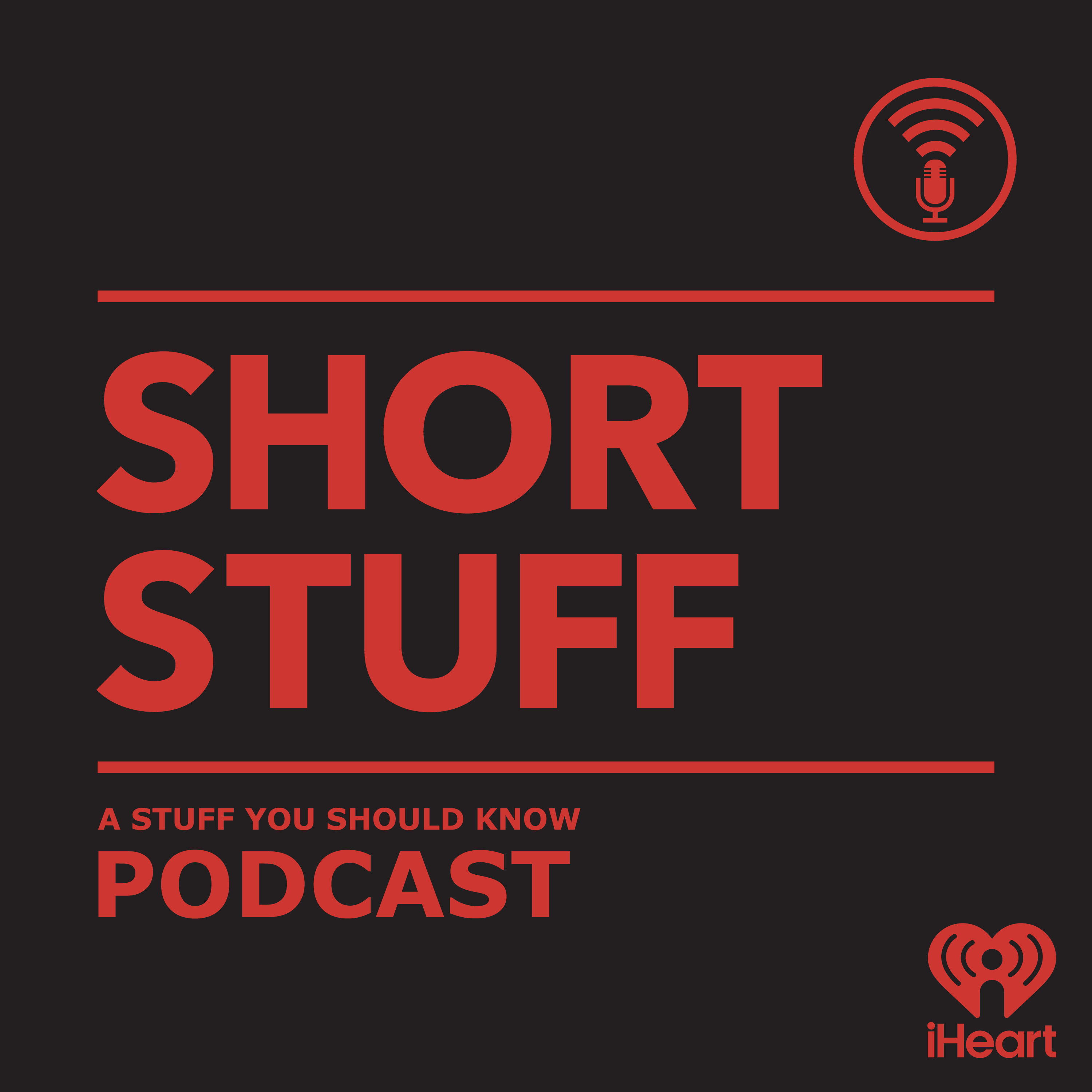Short Stuff: Bliss Point
The food we eat – especially the junk food – is a highly engineered technical marvel that’s designed to make you want nothing other than more! more! more! Learn about how food scientists make that possible by hijacking our brains.
See omnystudio.com/listener for privacy information.
Press play and read along
Transcript
Speaker 1 This is an iHeart podcast.
Speaker 2 Living with a rare autoimmune condition comes with challenges, but also incredible strength, especially for those living with conditions like myasthenia gravis or MG and chronic inflammatory demyelinating polyneuropathy, otherwise known as CIDP.
Speaker 3 Finding empowerment in the community is critical.
Speaker 2 Untold Stories, Life with a Severe Autoimmune Condition, a Ruby Studio production in partnership with Argenix, explores people discovering strength in the most unexpected places.
Speaker 2 Listen to Untold Stories on the iHeartRadio app, Apple Podcasts, or wherever you get your podcasts.
Speaker 5 Hey, and welcome to The Short Stuff.
Speaker 7 Josh, Chuck, Jerry, not Dave, but Dave still anyway, it's Shortstuff.
Speaker 9 That's right. Another banger of a job by you.
Speaker 9 Thanks to your research with Science and Food Journal, The Marketing Sage, Optimizing Nutrition, Across the Margin, our old friends at HowStuffWorks.com,
Speaker 9 mashed, and pinoleon, the pinole, whatever that is.
Speaker 10 That's right, right.
Speaker 11 Yeah, they were all very good resources because this is kind of like a wide-ranging topic.
Speaker 14 We're talking about bliss, the bliss point, which is essentially what food scientists have come up with to make you eat and crave junk food ceaselessly.
Speaker 9 Yeah, you have a pretty startling stat here out of the gate.
Speaker 9 The average American consumed, and this was a few years ago in 2022, 2022, 126.4 grams of sugar a day, which is 101 pounds or 46 kilos of sugar per American per year.
Speaker 9
Some people say it's like up to 150, which is a ton of sugar. In 1915, that number was about 17 and a half pounds.
And processed foods were developed in that time span, and that's literally to blame.
Speaker 15 Yeah, for sure.
Speaker 16 And that's added sugar.
Speaker 7 That's not like the sugar from fruit.
Speaker 14 It's the sugar that you could like put into a package and sell at the store.
Speaker 7 That's the sugar that they're counting right there.
Speaker 10 Yeah.
Speaker 12 And there's a guy named Michael Moss.
Speaker 19 He wrote a book that you probably have heard of called Salt, Sugar, and Fat.
Speaker 12 Came out, I don't know, within the last decade or so.
Speaker 21 But he talks about a market researcher named Howard Moskowitz.
Speaker 7 And Moskowitz basically gave us the food industry as we understand it today.
Speaker 14 And I looked up and down to see if he expressed any remorse at the end of his life.
Speaker 23 And he doesn't seem to have been anything but proud of his work but the reason he revolutionized the food industry is that in the 70s he identified the the idea of bliss points like it was almost a discovery is more than an invention and that is the the perfect balance between fat sugar and salt in any given food product it's not the same for every food product it's specific to each individual Dorito or Cheeto or whatever.
Speaker 8 And if you do it right, people are just going to eat those things constantly and they're not going to stop.
Speaker 24 They're going to have trouble stopping, in fact.
Speaker 9 Yeah, he was what's known as a psychophysicist. And they are people who look at the relationship between a stimulus and your brain's response to it.
Speaker 9
And in this case, we're talking about taste as far as the stimulus. And then as far as our brain's response, it's like, I want to eat all of that that I can.
Right.
Speaker 9 And he was a, eventually became known as like a really pretty brilliant market researcher who would pump out these really detailed reports on consumer
Speaker 9 on consumers consuming right yeah and some of these could be like over a hundred pages long like really drilled down to like kind of weird levels of specificity and granularity yeah and he would um discover a bliss point of something and i think he's really well known for helping prego the the saucier uh come up with their chunky variety and he introduced 32 different mustards and 17 different olive oils and a lot of other products to the market.
Speaker 9 Yeah.
Speaker 3 And again, by just doing this exhaustive market research and interviews and focus groups and testing to just figure out what people wanted and then figure out how to make it so that
Speaker 3 the most people would buy it because it had maximal palatability.
Speaker 9 Yeah. And we have bliss points for
Speaker 9
everything, basically. They're different for different macronutrients.
Bliss points for junk food are just heavily engineered to do that.
Speaker 9 But there are natural bliss points, like protein satisfies people pretty quickly. So I think
Speaker 9 Marty Kendall says on the optimizing nutrition blog.
Speaker 9 I had a pretty funny mistake that we beeped out.
Speaker 9 That if a food has a protein content of just 14%, that's going to make you feel satisfied.
Speaker 9 And that's why a lot of high-protein diets are recommended because you're just probably not going to eat as much because you can feel fuller and become satisfied more quickly.
Speaker 12 Yeah.
Speaker 8 And also, that's why you rarely find protein in junk food.
Speaker 18 Yeah, exactly. They don't want you to feel satisfied.
Speaker 11 They don't want you to feel satiated.
Speaker 24 They just want that bliss point such that your brain's just like, keep going, keep going.
Speaker 22 And the reason why salt, fat, and sugar are focused on is because those three combined basically set off all of our taste buds, right?
Speaker 11 Yeah.
Speaker 16 So it really like pumps out a huge message to our brain saying, like, this is amazing.
Speaker 13 Let's just eat this forever.
Speaker 27 and like you said everything kind of has a bliss point and also
Speaker 24 most foods or a lot of foods have these same three ingredients naturally but again these aren't the these foods like aren't really engineered to to keep us going to to maximalize the bliss point they just kind of have a natural version in it you know like an apple tastes good because it has its own bliss point but it's not so highly engineered that you don't just keep eating apple after apple
Speaker 9 Yeah, that would make you sick in your belly.
Speaker 18 Yes, because they're high in fiber.
Speaker 11 They're good for that.
Speaker 9 Yeah, should we take a break?
Speaker 11 Yeah, we should.
Speaker 9 Attention, parents and grandparents. If you're looking for a gift that's more than just a toy, give them something that inspires confidence and adventure all year long.
Speaker 9 Give them a Guardian bike, the easiest, safest, and number one kids' bike on the market.
Speaker 2 Yeah, with USA-made kids-specific frames and patented safety technology, kids are learning to ride in just one day with no training wheels needed.
Speaker 2 It's why Guardian is America's favorite kids' bike and the New York Times and Wirecutters' top pick three years in a row.
Speaker 9 That's right. My daughter has a Guardian bike, and she loves it, and that thing was really easy to put together.
Speaker 9 And get this, this holiday season, Guardian is offering their biggest deal of the year, over 40% in savings on all bikes, plus $100 in free accessories.
Speaker 9 Guardian bikes have have become one of the most sought-after gifts of the season, and inventory is going fast, so don't wait.
Speaker 9 Join over a half a million families who've discovered the magic of Guardian. Visit guardianbikes.com to shop now.
Speaker 2
This podcast is sponsored by PayPal. Okay, let's talk holiday shopping.
From now through December 8th, you can get 20% cash back when you pay in for with PayPal. No fees, no interest.
Speaker 2 And this limited time offer is perfect for the Black Friday and Cyber Monday deals you've been eyeing. Save the offer in the app now.
Speaker 2 So whether you're shopping for your foodie friend or outdoorsy uncle, PayPal helps you make the most of your money this holiday.
Speaker 6
Expires December 8th. See PayPal.com/slash promo terms, subject to approval.
Learn more at paypal.com/slash payin4. PayPal Inc., NMLS 910457.
Speaker 28 Well, now when you're on the road, driving in your truck, wanna learn a thing or two from Josh and Chuck. It's stuff you should know.
Speaker 11 Stuff you should know.
Speaker 6 All right.
Speaker 22 So again, salt, fat, sugar, these three things, if you can get that down, your food company will probably be successful
Speaker 24 if you can figure out how to just kind of put them together just right.
Speaker 8 And they serve other purposes too, like salt masks the taste of other ingredients pretty well.
Speaker 19 Sugar is also a preservative, so the shelf life of a product is extended from it.
Speaker 11 But really,
Speaker 14 taste is essentially what you're trying to do with this.
Speaker 22 But it goes to show you just how
Speaker 25 not precarious,
Speaker 22 just what a juggling act it is to come to the bliss point.
Speaker 12 So it's maximally palatable, but also there's enough sugar in there to keep your
Speaker 22 stovetop stuffing from turning bad on the shelf if you don't move them fast enough.
Speaker 9 Yeah, I mean, this is one of those that's kind of disappointing to learn how
Speaker 9 sort of they're not like, let's make something that people really like and that tastes awesome. They're like, let's make something that they will eat and eat and eat.
Speaker 9 That's why I just became German.
Speaker 12 That's the problem with the 20th century business mindset that's still around today.
Speaker 18 Hook your audience, and you'll have profits for your shareholders constantly.
Speaker 9 Yeah, from Doritos to social media.
Speaker 11 Yeah, it sucks.
Speaker 9 So we don't know, you know, you can't get a recipe for Dorito, you know, like an actual recipe.
Speaker 9 But that optimizing nutrition blog that you found,
Speaker 9 they looked at hundreds of thousands of food logs and came up with some pretty good guesses on sort of
Speaker 9 a prime bliss point
Speaker 9
ratio, I guess. Yeah.
Wherein sugar makes up or should make up about 23.5% of the calories, salt about 2.9 grams per 2,000 calories, and fat about
Speaker 9 24% of the food's calories. And again, this is not
Speaker 9 like the construction of a good diet. This is if you're looking to maximize that bliss point.
Speaker 11
Exactly. Yeah, it's not a good diet.
Right.
Speaker 7 So there's other things that come into play that food scientists have figured out along the way.
Speaker 18 Do you remember the chewy granola bar revolution of the early 90s?
Speaker 11 Yeah, sure.
Speaker 18 Those are good.
Speaker 12 Chewy mouthfeel was basically investigated, and they figured out how to maximize that.
Speaker 7 And then also crunchy, you know, you can't really sneeze at that.
Speaker 24 But
Speaker 7 the biggest invention or the biggest discovery, aside from Bliss Point, as far as food science goes, is vanishing caloric density, which is really important for junk food.
Speaker 9 Yeah, this is incredible. This is the idea that something that you put in your mouth to eat that has that sort of melt-in-your-mouth quality, your brain doesn't register that you are eating calories.
Speaker 9 So that's when, like, popcorn is one of them. That's why you can sit down and eat a giant tub of popcorn at the movies because it kind of has that melt-in-your-mouth feel.
Speaker 9 and your brain's not saying like maybe you should put this down because you're eating a lot of calories it doesn't signal your brain in that way and a little fact that i learned uh from your research that hits home to my family was that they have found that cheetos uh michael moss said that that is the perfect snack for as far as bliss point goes as far as the crunchy mouth feel the flavor ratio and most importantly that vanishing caloric density and my friend my wife emily
Speaker 9 has a cheeto problem such that we don't keep Cheetos in the house. She's like, I can't stop eating them when they're in the house.
Speaker 18 I know how she feels.
Speaker 20 I've got some products like that
Speaker 21 that I just don't keep in the house.
Speaker 10 You can't.
Speaker 13 I do have to say, though, that it's gotten easier and easier with just how ridiculous the prices are for chips these days.
Speaker 9 Yeah, chips are pricey.
Speaker 20 It's insane, Chuck.
Speaker 11 Like a bag of ruffles printed on the bag is $7.50
Speaker 11 for half of a bag of Ruffles potato chips. Now, that is insane.
Speaker 19 The only good part of it is hopefully more and more people are like, I'm not eating chips anymore.
Speaker 7 This is dumb.
Speaker 9 Yeah, I mean, we don't eat a lot of that stuff. You know, when we'll go to the lake for the weekends with like kids and stuff, we'll get like chips and dip, and that's always fun.
Speaker 9 I do have a French onion sun chip problem.
Speaker 11 Yeah.
Speaker 9 Oh, man, I love that so much.
Speaker 16 The mouthfeel of those turned me off, actually.
Speaker 9 Oh, I love it. And they also, they're one of those sort of evils that make you think you're eating sort of a healthy, like a multi-grain thing.
Speaker 9 And it's like, I don't think those are any healthier than a fried potato chip. Right.
Speaker 15 Well, here, take my hand and help me off on my soapbox because I have a follow-up question about Emily's Cheeto problem.
Speaker 18 All right, let's hear it.
Speaker 23 Does she like the original Cheetos, the straight-ahead version, or is she more like a fiery, hot version kind of Cheeto lover?
Speaker 9 No, she's a standard Cheeto, and to be specific, not a cheese puff either,
Speaker 9 like a real Cheeto, like a Fred Flintstone Club Cheeto.
Speaker 9
But it's funny that she accidentally got some of those flaming hots, and Ruby was like, I want to try those. And we're like, no, those are way too hot.
You can't eat those.
Speaker 9
And she was like, no, I can handle it. And she ate it.
And it was one of those things where you can see like her eyes starting water. And she was like, these are really good.
I like these.
Speaker 18 She played it off.
Speaker 9
Oh, yeah. She's like, I want to take those to school.
And then we later found she was trading them. I'm sure.
Yeah.
Speaker 11 She's like, here, try one of these. You'll love it.
Speaker 9 Exactly.
Speaker 20 So, okay, okay, so just figuring out the bliss point is not enough.
Speaker 4 You don't just figure it out and release it.
Speaker 16 You try a million different combinations.
Speaker 10 Maybe not a million, but not that far off.
Speaker 19 And you test it with people.
Speaker 3 That's how you fine-tune everything and get it just right so that you find that bliss point that's going to help you sell as much.
Speaker 14 And so those taste tests can like really start to add up.
Speaker 17 There's some legendary ones, as a matter of fact.
Speaker 8 One of them is Prego Chunky.
Speaker 9 Yeah, we mentioned that earlier. They had 45 different versions of Prego Chunky that they were testing until they got to their main one.
Speaker 9 And then I'm going to let you handle the Dr. Pepper because that's just amazing.
Speaker 12 Cherry Vanilla Dr.
Speaker 14 Pepper, they went through 61 different versions and 4,000 different taste tests before they finally released it.
Speaker 11 It's not bad.
Speaker 9
I've never tried it. I mean, I'm not a Dr.
Pepper guy. It's such a specific...
I don't like hate it, but it's just not one I go to.
Speaker 18 I'm not either.
Speaker 4 Or wait, maybe it's the cream soda Dr.
Speaker 8 Pepper that's not bad.
Speaker 8 I don't really drink it either, but I tried one once and I was like, that's actually pretty good.
Speaker 20 Yeah. What about Oreos, Chuck?
Speaker 4 Because one of the things they've become known for in the last few years is releasing just nut-so flavors all the time.
Speaker 9 Yeah, and you know, this is probably the Gen X in me coming out, but I love a
Speaker 9 not, I do love a standard Oreo, but to me, they hit peak Oreo with the double stuff standard. Oh, really?
Speaker 16 You don't like lemon?
Speaker 9 No, I mean,
Speaker 9 I'm not into lemony dessert desserts.
Speaker 7 Yeah, you probably wouldn't like lemon Oreos then. I think they're very good.
Speaker 12 And I also think some of the limited editions they've come out with are pretty good.
Speaker 7 Like birthday cake, which is the first one they did to commemorate their 100th birthday back in 2012.
Speaker 25 To me,
Speaker 25 it was very good.
Speaker 10 I think it's still around.
Speaker 4 To me, the pinnacle was Rice Krispie Treats Oreos.
Speaker 11 They were
Speaker 12 amazing.
Speaker 9 That sounds so good.
Speaker 19 They were were really, really good.
Speaker 27 If they re-released any,
Speaker 25 I would definitely go get those.
Speaker 24 But I've very fortunately been like, I should probably stop buying like crazy flavored Oreos because I just eat the whole bag like in one sitting, basically.
Speaker 11 Oh, man.
Speaker 9 Glass of cold, whole milk.
Speaker 11 Yeah.
Speaker 20 Oreos go really well with that.
Speaker 10 But oh, the reason why that they've been releasing so many flavors is that they figured out when they release a crazy flavor, it gets lots of press.
Speaker 4 So it gets people to the stores, right?
Speaker 10 And they found that when people are at the stores to buy that crazy-flavored Oreo, they apparently remember how much they love the original Oreos, like you, so they buy both.
Speaker 10 Yeah, that's great to an extent.
Speaker 7 I guess it's great for Nabisco.
Speaker 9 Yeah, I bet that was a finding too, where they were like, Oh my god, look, look what's happening. Yeah, Chuck went to get a Lady Gaga Oreo, and he got the double stuff as well.
Speaker 11 I know, that's so weird.
Speaker 7 That was one of the flavors.
Speaker 24 Um, and I guess before we sign off, Chuck, I think we should remind everybody, as we have many times, Oreo is the knockoff, Hydrox was the original.
Speaker 11 That's right.
Speaker 24 Everybody's short stuff is out.
Speaker 1 Stuff You Should Know is a production of iHeartRadio. For more podcasts from iHeartRadio, visit the iHeartRadio app, Apple Podcasts, or wherever you listen to your favorite shows.



